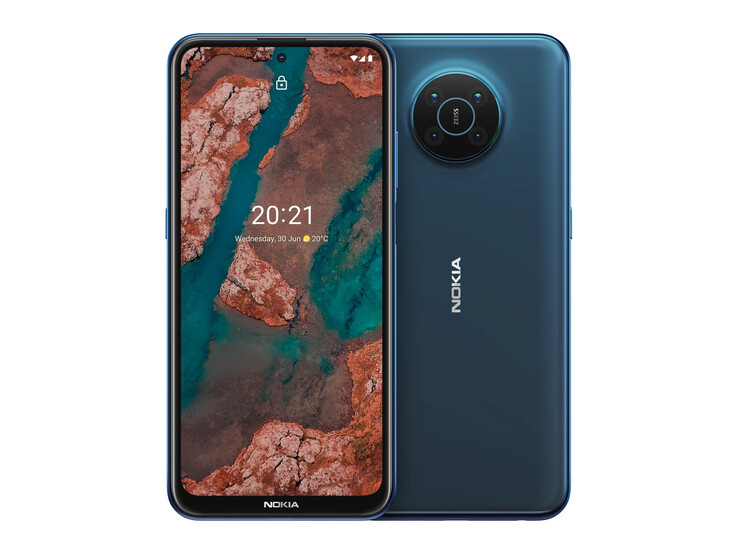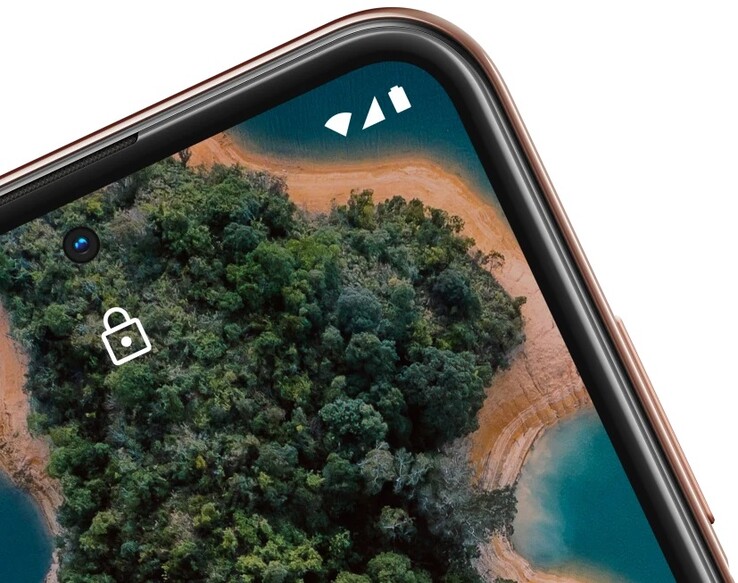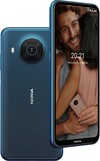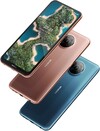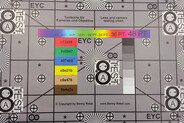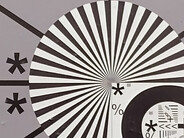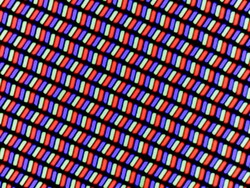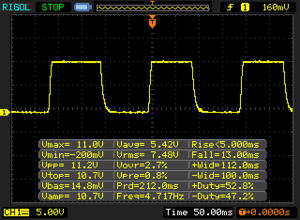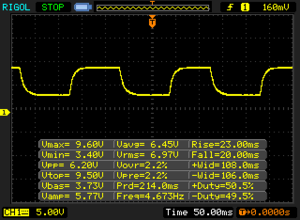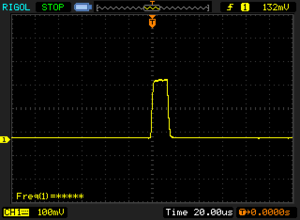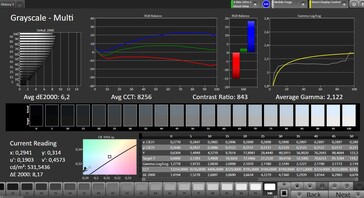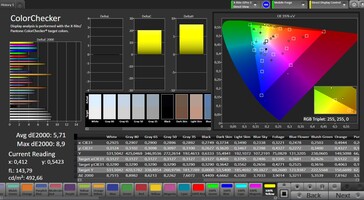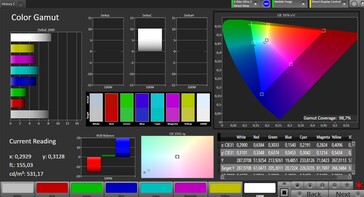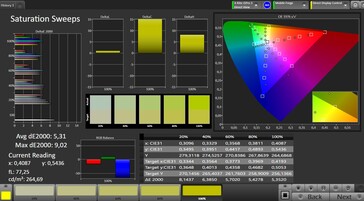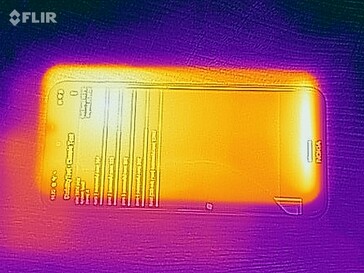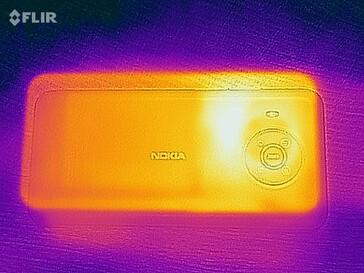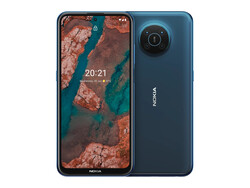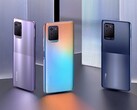Nokia X20 smartphone review - Long warranty and 5G
Possible competitors in comparison
Rating | Rating Version | Date | Model | Weight | Drive | Size | Resolution | Price from |
|---|---|---|---|---|---|---|---|---|
| 80.6 % v7 (old) | v7 (old) | 05 / 2021 | Nokia X20 SD 480, Adreno 619 | 220 g | 128 GB UFS 2.1 Flash | 6.67" | 2400x1080 | |
| 82.9 % v7 (old) | v7 (old) | 08 / 2020 | Xiaomi Mi Note 10 Lite SD 730G, Adreno 618 | 204 g | 64 GB UFS 2.0 Flash | 6.47" | 2340x1080 | |
| 83.6 % v7 (old) | v7 (old) | 09 / 2020 | Google Pixel 4a SD 730G, Adreno 618 | 143 g | 128 GB UFS 2.0 Flash | 5.80" | 2340x1080 | |
| 83 % v7 (old) | v7 (old) | 04 / 2021 | Samsung Galaxy A52 5G SD 750G 5G, Adreno 619 | 189 g | 128 GB UFS 2.1 Flash | 6.50" | 2400x1080 |
Case, features and handling - Quite heavy and with Gorilla Glass 5
The Nokia X20 is a mid-range phone. It is 5G-capable and for now the fastest Nokia smartphone under the new naming. If you compare it with the devices of the last generation, it can probably be best described as the successor of the Nokia 5.4 ...
The casing is made of plastic at the back, and the screen is protected by Gorilla Glass 5. The back is matte and shimmers either bluish or orange, depending on the selected color. It thus looks chic, but is not as well protected from fingerprints. The chassis is quite sturdy, but can be easily dented in the center.
The Nokia X20 is a large, wide and also quite heavy smartphone, so it is rather less suitable for small hands.
Pure Android 11 without additionally installed apps is installed on the smartphone. What we noticed: There seems to be a bug with the app switcher. It sometimes does not display any apps, even though they are running in the background. Previews of the apps usually do not load; there are only completely white or black windows.
Nokia strives to become more sustainable and therefore omits the charger in the package. If you already have a charger at home or need a new one, Nokia has listed exactly which specs you need on this website which specs are best to bring along. Instead of the charger, you get a cover made of compostable material as an accessory, which is supposed to protect the smartphone from bumps and thus extend the lifespan as much as possible
Nokia also offers a detailed environmental profile of its smartphone on the Internet on the Internet. In addition, there is a 3-year warranty and the promise for 3 years of software updates, so you can use your smartphone longer.
The Nokia X20 is a 5G smartphone. Although this is becoming more and more common in the price range around 400 Euros, it is not yet a matter of course. WiFi 5, on the other hand, is standard. Nokia's X20 is a bit slower than similarly priced devices in our test with the reference router Netgear Nighthawk AX12.
| Cross Platform Disk Test (CPDT) | |
| SDCard Sequential Write 0.5 GB | |
| Samsung Galaxy A52 5G (Toshiba Exceria Pro M501) | |
| Average of class Smartphone (20.9 - 46.9, n=65, last 2 years) | |
| Nokia X20 (Angelbird V60) | |
| SDCard Sequential Read 0.5 GB | |
| Nokia X20 (Angelbird V60) | |
| Samsung Galaxy A52 5G (Toshiba Exceria Pro M501) | |
| Average of class Smartphone (43.4 - 81.5, n=65, last 2 years) | |
Cross Platform Disk Test (CPDT)
| Networking | |
| iperf3 transmit AX12 | |
| Google Pixel 4a | |
| Xiaomi Mi Note 10 Lite | |
| Samsung Galaxy A52 5G | |
| Nokia X20 | |
| iperf3 receive AX12 | |
| Google Pixel 4a | |
| Xiaomi Mi Note 10 Lite | |
| Samsung Galaxy A52 5G | |
| Nokia X20 | |
Cameras - 3 usable lenses in Nokia phone
There are a total of 4 lenses on the back, but only 3 of them can really be used for taking pictures: The main camera with 64 megapixels, the wide-angle camera with 5 megapixels and a macro lens with 2 megapixels.
The main camera, as is now common for most cameras, uses pixel binning to combine four pixels at a time into one pixel. This allows a higher light yield to be achieved. However, the full resolution can also be used in a special mode
Photos look quite good at first glance, but fine details are lacking and the dynamics are noticeably weaker than in more expensive smartphones. We like the image sharpness under normal lighting conditions. In low light and high contrasts, the image brightens up well, but the sharpness is lost a bit.
Pictures from the wide-angle camera are quite dim and not really sharp. The camera is sufficient for snapshots on bright days
Interesting: A custom watermark can be set via the camera software, which can then be reflected in the pictures.
Videos can be recorded in a maximum of 1080p with 60 fps. We would expect 4K video recording in this price range.
The front-facing camera also uses pixel binning and takes decent selfies if you do not pay too much attention to details.
Image comparison
Choose a scene and navigate within the first image. One click changes the position on touchscreens. One click on the zoomed-in image opens the original in a new window. The first image shows the scaled photograph of the test device.
Hauptkamera BlumeHauptkamera UmgebungHauptkamera Low LightWeitwinkelkamera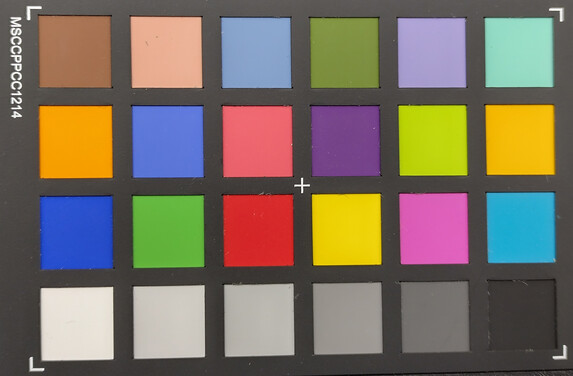
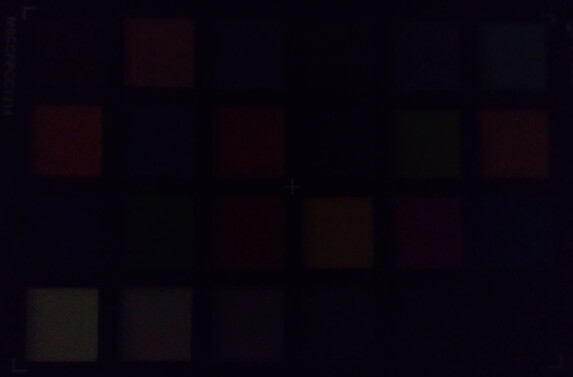
Display - Nokia without PWM
With just under 617 cd/m² as an average value, the display of Nokia's X20 is on class level in terms of brightness. You should be able to use the smartphone outdoors even on very bright days. Samsung with its Boost mode for bright environments manages even more luminosity, though.
Since it is an IPS panel, there is no perfect black like in the comparison models. The black value of 0.7 cd/m² is even quite high, resulting in a contrast ratio of less than 1000:1. Those looking for a particularly true-color display should also look elsewhere.
| |||||||||||||||||||||||||
Brightness Distribution: 89 %
Center on Battery: 646 cd/m²
Contrast: 923:1 (Black: 0.7 cd/m²)
ΔE ColorChecker Calman: 5.71 | ∀{0.5-29.43 Ø4.78}
ΔE Greyscale Calman: 6.2 | ∀{0.09-98 Ø5}
98.7% sRGB (Calman 2D)
Gamma: 2.122
CCT: 8256 K
| Nokia X20 IPS, 2400x1080, 6.7" | Xiaomi Mi Note 10 Lite AMOLED, 2340x1080, 6.5" | Google Pixel 4a OLED, 2340x1080, 5.8" | Samsung Galaxy A52 5G Super AMOLED, 2400x1080, 6.5" | |
|---|---|---|---|---|
| Response Times | 67% | 80% | 90% | |
| Response Time Grey 50% / Grey 80% * (ms) | 43 ? | 10 ? 77% | 8.8 ? 80% | 3.2 ? 93% |
| Response Time Black / White * (ms) | 18 ? | 8 ? 56% | 3.6 ? 80% | 2.4 ? 87% |
| PWM Frequency (Hz) | 176.1 | 255.1 ? | 250 ? | |
| Screen | 41% | 46% | 32% | |
| Brightness middle (cd/m²) | 646 | 605 -6% | 705 9% | 744 15% |
| Brightness (cd/m²) | 617 | 608 -1% | 707 15% | 749 21% |
| Brightness Distribution (%) | 89 | 95 7% | 96 8% | 98 10% |
| Black Level * (cd/m²) | 0.7 | |||
| Contrast (:1) | 923 | |||
| Colorchecker dE 2000 * | 5.71 | 0.84 85% | 0.9 84% | 2.2 61% |
| Colorchecker dE 2000 max. * | 8.9 | 1.8 80% | 1.9 79% | 7 21% |
| Greyscale dE 2000 * | 6.2 | 1.3 79% | 1.3 79% | 2.1 66% |
| Gamma | 2.122 104% | 2.211 100% | 2.26 97% | 2.06 107% |
| CCT | 8256 79% | 6310 103% | 6576 99% | 6516 100% |
| Total Average (Program / Settings) | 54% /
47% | 63% /
54% | 61% /
47% |
* ... smaller is better
Display Response Times
| ↔ Response Time Black to White | ||
|---|---|---|
| 18 ms ... rise ↗ and fall ↘ combined | ↗ 5 ms rise | |
| ↘ 13 ms fall | ||
| The screen shows good response rates in our tests, but may be too slow for competitive gamers. In comparison, all tested devices range from 0.1 (minimum) to 240 (maximum) ms. » 39 % of all devices are better. This means that the measured response time is better than the average of all tested devices (20.2 ms). | ||
| ↔ Response Time 50% Grey to 80% Grey | ||
| 43 ms ... rise ↗ and fall ↘ combined | ↗ 23 ms rise | |
| ↘ 20 ms fall | ||
| The screen shows slow response rates in our tests and will be unsatisfactory for gamers. In comparison, all tested devices range from 0.165 (minimum) to 636 (maximum) ms. » 70 % of all devices are better. This means that the measured response time is worse than the average of all tested devices (31.6 ms). | ||
Screen Flickering / PWM (Pulse-Width Modulation)
| Screen flickering / PWM not detected | |||
In comparison: 53 % of all tested devices do not use PWM to dim the display. If PWM was detected, an average of 8108 (minimum: 5 - maximum: 343500) Hz was measured. | |||
Performance, emissions, and battery runtime - SoC on par
The still quite new Snapdragon 480 5G is used as the SoC in Nokia's X20. Thanks to the 8 nm manufacturing process, more modern cores and higher clock rate, it is significantly more powerful than the predecessor Snapdragon 460. Thus, the Nokia X20 still lags slightly behind other devices in the price range in terms of performance, but the gap is minimal. The performance remains on a high level even during longer load.
Since the considerably faster Adreno 619 is installed as the graphics module, the graphics performance is also almost on par with the other devices in this price range, which are all equipped with SoCs from the Snapdragon 7 series.
The Nokia X20 does not break any speed records with the UFS 2.1 storage, but it can largely keep up with the other devices.
A clearly noticeable heating up to 44.1 °C is present in the upper front area when the device is loaded for a longer time. This is tolerable in itself, but can become unpleasant on hot summer days.
The mono speaker is located on the bottom edge. The sound is quite treble-emphasized, which is even more noticeable at maximum volume. Nokia's X20 also offers a 3.5 mm jack or Bluetooth 5.0 for sound transmission to external devices.
With 4470 mAh, Nokia's X20 does not offer the highest-capacity battery in the price range despite its quite heavy casing. Nevertheless, the runtimes of 14:39 hours in our Wi-Fi test are quite good and are also sufficient for several days away from the power socket in normal use. The smartphone can be charged with a maximum of 18 watts. The device is fully charged again after approximately 110 minutes.
| PCMark for Android - Work 2.0 performance score (sort by value) | |
| Nokia X20 | |
| Xiaomi Mi Note 10 Lite | |
| Google Pixel 4a | |
| Samsung Galaxy A52 5G | |
| Average Qualcomm Snapdragon 480 5G (6380 - 7713, n=2) | |
| GFXBench | |
| on screen Aztec Ruins Normal Tier Onscreen (sort by value) | |
| Nokia X20 | |
| Xiaomi Mi Note 10 Lite | |
| Google Pixel 4a | |
| Samsung Galaxy A52 5G | |
| Average Qualcomm Snapdragon 480 5G (16 - 31, n=9) | |
| Average of class Smartphone (6.2 - 166, n=209, last 2 years) | |
| 1920x1080 Aztec Ruins Normal Tier Offscreen (sort by value) | |
| Nokia X20 | |
| Xiaomi Mi Note 10 Lite | |
| Google Pixel 4a | |
| Samsung Galaxy A52 5G | |
| Average Qualcomm Snapdragon 480 5G (17 - 19, n=9) | |
| Average of class Smartphone (3.4 - 367, n=209, last 2 years) | |
| on screen Aztec Ruins High Tier Onscreen (sort by value) | |
| Nokia X20 | |
| Xiaomi Mi Note 10 Lite | |
| Google Pixel 4a | |
| Samsung Galaxy A52 5G | |
| Average Qualcomm Snapdragon 480 5G (9.9 - 19, n=9) | |
| Average of class Smartphone (0.85 - 144, n=210, last 2 years) | |
| 2560x1440 Aztec Ruins High Tier Offscreen (sort by value) | |
| Nokia X20 | |
| Xiaomi Mi Note 10 Lite | |
| Google Pixel 4a | |
| Samsung Galaxy A52 5G | |
| Average Qualcomm Snapdragon 480 5G (6.4 - 6.7, n=9) | |
| Average of class Smartphone (1.2 - 146, n=209, last 2 years) | |
| Nokia X20 | Xiaomi Mi Note 10 Lite | Google Pixel 4a | Samsung Galaxy A52 5G | Average 128 GB UFS 2.1 Flash | Average of class Smartphone | |
|---|---|---|---|---|---|---|
| AndroBench 3-5 | -21% | -4% | 31% | 1% | 217% | |
| Sequential Read 256KB (MB/s) | 489.3 | 501 2% | 502 3% | 927 89% | 761 ? 56% | 2228 ? 355% |
| Sequential Write 256KB (MB/s) | 462.7 | 213.2 -54% | 246.8 -47% | 484.6 5% | 296 ? -36% | 1852 ? 300% |
| Random Read 4KB (MB/s) | 165.4 | 134.6 -19% | 162.9 -2% | 176.1 6% | 154 ? -7% | 296 ? 79% |
| Random Write 4KB (MB/s) | 144.6 | 125.8 -13% | 187.4 30% | 179.2 24% | 130.4 ? -10% | 339 ? 134% |
Temperature
(±) The maximum temperature on the upper side is 44.1 °C / 111 F, compared to the average of 35.2 °C / 95 F, ranging from 21.9 to 247 °C for the class Smartphone.
(±) The bottom heats up to a maximum of 43.9 °C / 111 F, compared to the average of 34 °C / 93 F
(+) In idle usage, the average temperature for the upper side is 26 °C / 79 F, compared to the device average of 32.9 °C / 91 F.
Loudspeaker
Nokia X20 audio analysis
(+) | speakers can play relatively loud (83.4 dB)
Bass 100 - 315 Hz
(-) | nearly no bass - on average 25.3% lower than median
(±) | linearity of bass is average (11.6% delta to prev. frequency)
Mids 400 - 2000 Hz
(±) | higher mids - on average 8% higher than median
(±) | linearity of mids is average (7.5% delta to prev. frequency)
Highs 2 - 16 kHz
(±) | higher highs - on average 6.8% higher than median
(±) | linearity of highs is average (8.4% delta to prev. frequency)
Overall 100 - 16.000 Hz
(±) | linearity of overall sound is average (27% difference to median)
Compared to same class
» 69% of all tested devices in this class were better, 5% similar, 25% worse
» The best had a delta of 11%, average was 35%, worst was 134%
Compared to all devices tested
» 82% of all tested devices were better, 4% similar, 14% worse
» The best had a delta of 4%, average was 24%, worst was 134%
Samsung Galaxy A52 5G audio analysis
(+) | speakers can play relatively loud (89 dB)
Bass 100 - 315 Hz
(-) | nearly no bass - on average 27.3% lower than median
(±) | linearity of bass is average (11.4% delta to prev. frequency)
Mids 400 - 2000 Hz
(±) | reduced mids - on average 6.2% lower than median
(+) | mids are linear (4.4% delta to prev. frequency)
Highs 2 - 16 kHz
(±) | higher highs - on average 5% higher than median
(+) | highs are linear (3.3% delta to prev. frequency)
Overall 100 - 16.000 Hz
(±) | linearity of overall sound is average (19.3% difference to median)
Compared to same class
» 26% of all tested devices in this class were better, 9% similar, 65% worse
» The best had a delta of 11%, average was 35%, worst was 134%
Compared to all devices tested
» 46% of all tested devices were better, 8% similar, 47% worse
» The best had a delta of 4%, average was 24%, worst was 134%
Battery life
| Nokia X20 4470 mAh | Samsung Galaxy A52 5G 4500 mAh | Xiaomi Mi Note 10 Lite 5260 mAh | Google Pixel 4a 3140 mAh | Average of class Smartphone | |
|---|---|---|---|---|---|
| Battery Runtime | |||||
| WiFi Websurfing (h) | 14.7 | 11.8 -20% | 18.3 24% | 11.2 -24% | 19.3 ? 31% |
Pros
Cons
Verdict - Good cell phone with sustainability aspects
Looking at the model number of the SoC, one might suspect bad things: After all, the Snapdragon 4 series was previously intended more for entry-level devices. But the new Snapdragon 480 5G does almost as good a job as the more expensive mid-range SoCs from last year. Thus, the currently most expensive of Nokia's new smartphones is on par with older devices, but there should be much faster devices for the same money in the near future. Thus, the decision for the SoC is not very forward-looking.
However, those who are looking for a mid-range device with 5G, a decent camera, pure Android, a long warranty and without PWM flickering on the screen will find what they are looking for here
The device is less suitable for those who want a light and handy smartphone. Nokia's X20 simply has too much screen space for that and is quite heavy. The IPS screen does not offer accurate colors and is also quite low in contrast, so fans of OLED displays will probably turn away.
Nokia's X20 is a mid-range smartphone with a long warranty, good runtimes, and 5G.
It is commendable that Nokia tries to become more sustainable. The protective cover made of compostable material instead of the charger might not be to everyone's taste, but at least it shows that it does not always have to be environmentally harmful plastic. In order to protect itself against accusations of money-making, Nokia also donates all the money that is earned with the sale of chargers. The manufacturer is at least concerned about the environmental impact of its devices, and that alone is a step in the right direction.
Price and availability
At the time of testing, the Nokia X20 is available directly from the manufacturer available. It is also available in some online stores, but mainly from Austria. The device is now also available from German retailers, for example Cyberport or amazon.de.
Nokia X20
- 05/04/2021 v7 (old)
Florian Schmitt




